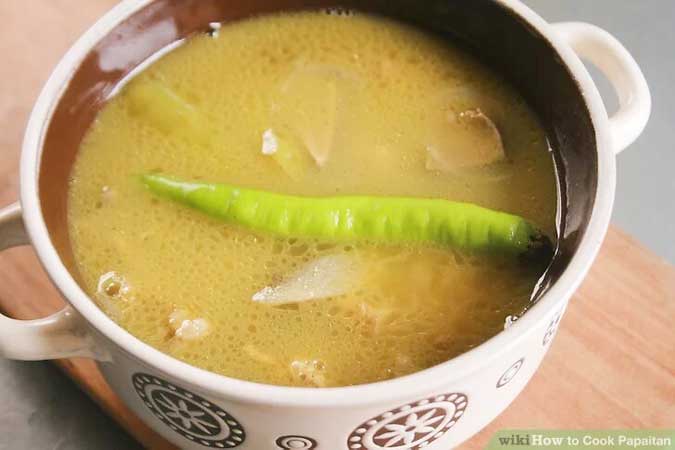2020 Doreen Gamboa Fernandez Food Writing Award: Bile — More than just an unlikely condiment

By Jeanne Rebollido Jacob-Ashkenazi
(Second Prize winner of the 2020 Doreen Gamboa Fernandez Food Writing Award)
OF THE FLAVORS that the human tongue can detect — salty, sweet, sour, bitter, and savory (umami), bitter is the least acceptable and provokes the most aversion. From an evolutionary perspective, rightly so, as many bitter substances are toxic, and humans are programmed to avoid them.
And yet strangely, bitterness characterizes the well-loved dishes of regional cuisines: Pinapaitan (soup of beef or goat innards), Kilawen (raw or half-cooked beef or goat in vinegar), and Kappukan (boiled innards of goat with vinegar) of the Ilocos, and Kinigtot (a stew of goat meat and innards simmered in spices and bile juice) and Sinanglaw (soup of beef and beef offal flavored with kamias and bile juice) of Pangasinan. These dishes owe their bitterness to bile and, sometimes additionally, chyme (partially digested fodder).
Northern Filipinos are not the only ones partial to bitter flavors. The Dai ethnic group in southern Yunnan is noted for its celebratory banquet called Sa Pie, which includes dishes laced with bile and chyme. Its closest neighbors, the Isan ethnic community in northern Thailand and Laotians, also feature bile in their version of steak tartare called Laap (also spelled Larb). Further afield in Italy, chyme from unweaned calves furnishes the sauce for a Roman dish called Pajata.
What explains the popularity of these bitter substances as condiments? These dishes, with the exception of Sa Pie and Pajata, are drinking foods, usually prepared by men to be eaten with other men. There may be an underlying, unstated theme of machismo on display here through the eating of extremely bitter foods, not dissimilar to extreme chili-eating competitions. However, Ilocanos assert that bile serves to mangpatibker — that it enhances health and is a stamina-builder. Surely there are other pleasant-tasting foods that restore energy and preserve health, such as eggs, fatty fish, lean meats. So what makes bile so attractive as a condiment and flavoring?
A clue may be found in what makes other bitter substances such as coffee, tea, cocoa, beer, alcoholic drinks, or bitter melon acceptable, and eventually palatable and sought-after. Our first experience of these bitter-tasting foods makes us reject them, especially when we do so as children. As we continue eating or drinking them however, we gradually overcome our initial aversion.
Surely psychological and socio-cultural factors are also at play, but research on taste offers solid evidence as to why. The change from outright aversion to liking is apparently due to the 1,000 specific proteins in our saliva. Recent research into ingestive behavior at the University of Buffalo found that what we eat determines the make-up of our saliva proteins, and these in turn modulate our sense of taste. Hence, while the first exposure to bitter foods may be a turn-off, subsequent exposure becomes enjoyable as our salivary proteins reconfigure themselves accordingly (unless we are supertasters of bitterness).
This still doesn’t address why regular consumers of bile-flavored foods believe that doing so enhances their stamina and improves their health. It now appears that bitterness is perceived by bitter taste receptors that exist not just in our tongue, but also throughout the body. What are they doing there? Researchers at the University of Massachusetts Medical School found that bitter taste receptors (called T2Rs, also Ta2Rs) in the respiratory system function as our first line of defense against harmful microorganisms by triggering the release of bactericides. In the digestive system, T2Rs induce the flushing of toxic substances to limit their harmful effects, regulate food intake, and deter parasitic infection. Likewise, T2Rs in the genito-urinary system sense harmful substances during fertilization. Hence, eating bile (among other bitter substances) triggers the body’s innate immunity, thus supporting disease prevention and promoting health.
Chinese traditional medicine has long recognized bile’s therapeutic functions. Ox, water buffalo bile, and goat bile are cited in its oldest prescription records.* The active ingredient of bear bile, the most widely prescribed, was found to be ursodeoxycholic acid (a bile acid), currently medically approved for liver conditions.** This led to further investigations on the functions of bile acids as therapeutic agents. Besides bile’s acknowledged role in fat digestion and absorption of vitamins A, D, E, and K, current biochemical research is clarifying the extensive therapeutic role of bile acids and their interaction with gut microorganisms in liver metabolism and metabolic conditions, such as obesity and diabetes.*** Thus, contemporary bile research staunchly supports the centuries-old adage “bitter in the mouth, healthy in the stomach” — confirming what lovers of Pinapaitan, Kilawen, Kinigtot, Sinanglaw, Sa Pie, and Laap may have intuitively known all along.
*Wang, David Q-H and Martin C. Carey. Therapeutic uses of animal biles in traditional Chinese medicine: An ethnopharmacological, biophysical chemical and medicinal review. World J Gastroenterol. 2014 Aug 7; 20(29): 9952–9975.
**Hofmann, Alan F. The continuing importance of bile acids in liver and intestinal disease. Arch Intern Med. 1999;159(22):2647-2658.
***Feng CC, Zhang AH, Miao JH, Sun H, Wang XJ, et al. Recent advances in understanding cross-talk between bile acids and gut microbiota. Open J Proteom Genom 2018; 3(1):024-034.
THE DOREEN Gamboa Fernandez Food Writing Award (DGF Award) recently announced the winners of the 2020 competition. The subject matter was “Livestock,” which, in the Philippines refers to cattle, pigs, goats, carabaos, and horses. The DGF Award is now in its 19th year. Named after the late dean of food writers, Doreen Gamboa Fernandez, it was founded to encourage writers to contribute to Philippine food literature. The winning essays of the first 15 years have been published in two books — Savor the Word and Sangkap.



